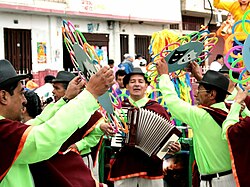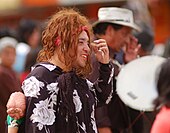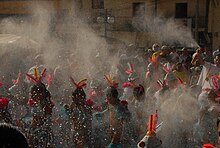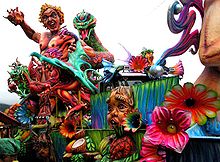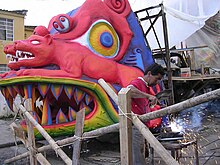Black and White Carnival
The Black and White Carnival is the largest and most important festival in southern Colombia. Although due to its geographical indication it belongs to the city of Pasto, it has also been adopted by other municipalities in the department of Nariño and in southwestern Colombia. It is celebrated from December 28 to January 7 of each year, and attracts a considerable number of Colombian and foreign tourists.
On September 30, 2009, it was declared Intangible Cultural Heritage of Humanity by the UNESCO committee.
Origin
The Carnival of Blacks and Whites has its origin in the fusion of multiple cultures and expressions, corresponding to the Andes, the Amazon and the culture of the Pacific. The carnival of blacks and whites was born in the XVI century in the year 1546. This fact characterizes it and distinguishes it from other similar expressions, starting with the date on that is carried out, which has a purely indigenous origin, since it coincides with the celebration of the Moon (Quilla), which is reminiscent of the rituals carried out by the pastures and the quilla singas, agrarian cultures that, at harvest time, honored with dances to the moon, and in other rituals they prayed to the sun, to protect their crops.
These celebrations, with the fusion and influence of Spanish culture, give rise to Hispanic religious syncretism, which generates expressions of what will be the Pasto carnival. In the XIX century, the authorities prohibited these festivities to avoid indigenous uprisings, and around 1834 the Indian festivities reappeared with its churumbeles, the mestizos with masquerades and mainly the noise of neighbors, all these festivals duly framed in the religious calendar, mainly with the festivities of the Virgen de las Mercedes (September 24) and the Immaculate Conception of Mary (December 8)..
In those times, on the eve of Three Kings Day, the little black game was also held spontaneously and festively, mainly between whites and mestizos, due to the low presence of the black population in Pasto. This festivity contrasted by the extroversion of a community characterized by a peaceful and taciturn life, which found in those days an opportunity to break the established.
Its origin was a "holiday" to blacks, originating in Gran Cauca, a region to which Pasto belonged. In 1607 there was a slave rebellion in Remedios, Antioquia that caused panic among the colonial authorities. This event was remembered by the large black population of Popayán who demanded a day of rest in which they could be truly free. To preserve social peace, the Spanish Crown granted January 5, for this purpose.
“The PRÍNCIPE, VACO DAY FOR SLAVOUS NEGS.” Now by understanding this relationship and request of many Black slaves of that province I come to say to you in a voice that the request is paternally received and will be vaguely given to Blacks and will be on January 5, the eve of the feast of the Holy Majesties and venerating esteem for the Holy Majesty of the Black King. Dated in Madrid. “I the Prince.”
This news was released by the faction in Popayán and that is how January 5th is declared a day off for people of color; the black population of the capital of Cauca took to the streets to dance to the rhythm of African music and began to paint the famous white walls of that population black. Subsequently, this custom spread throughout the south, taking on unusual strength in the cold city of Pasto, where the chronicler José María Cordobés Moure tells us, there are already vestiges that it was played around 1854. This is how the genesis of the Negros game was configured. and Blancos de Pasto, and in this way he would spend his first decades.
The game of Whites, an important part of the carnival, was born at dawn on Three Kings Day (January 6) in 1912, founded on the need to express imagination, play, friendship and share the joy that for those dates revives life. In a fine and exclusive brothel in the city, the house of the young ladies Robby located on Calle Real (now Carrera 25), The audacity of the group of tailors from the famous tailor shop owned by Don Ángel Zarama, among whom were Ángel María López and Máximo Erazo, leads them to take the French compact from one of the most sought-after ladies and proceeds to spread the powder with women's perfume, among all those present with the cry of Long live the Whites!, as a response to the already traditional game of Blacks. It didn't take long for the master cutter's companions to become victims first and then participants in the game. Then, everyone would go out into the street to repeat the joke with the unsuspecting parishioners who were coming out of the Three Kings Mass in the church of San Juan Bautista, repeating Long live the Blacks and long live the Whites!, an expression that under the custody of the Galeras, will be inserted forever and with vigor in the essence of the Pasto people.
Establishment
It is not until the mid-20s, of the XX century, that the current party is acquiring corpus, in the one in which other instances, times and spaces are combined, giving it a more urban and inclusive character. In 1926, the older students of the schools and the University of Nariño decided to actively participate in the party, choosing Romelia Martínez as their queen, and going out through the streets dressed in costumes in comparsas and dancing to the sound of regional music, in which constitutes the first parade, no longer on Three Kings Day, but on January 6, or White Day.
On January 4, 1929, a cavalcade of more than one hundred and fifty horsemen was preparing to stage the games on January 5 and 6, for which they had gathered in front of the Boyacá Battalion. At three in the afternoon and when the riders were ready for the great parade, a family made up of the father, the mother, two girls, children, three young men who rode on tired nags and who were followed by peons who herded the mules loaded with flasks, and making efforts so that some pigs and sheep did not disband and carrying cages with parrots and monkeys on their backs, without forgetting the "mica" (potty chair). He was a settler from Antioquia with his family who, after spending many years in the east (Putumayo), had decided to leave the jungle to return to "civilized" land.
Alfredo Torres Arellano and Carlos Martínez Madroñero, organizers of the parade, ordered two of the cavalcade to open up the field and neither short nor lazy included the travelers among the happy riders who made the parade minutes later. Joyful those who came from the east for such an unexpected encounter and without knowing why so lively "tope" they occupied the center surrounded by the horsemen in the process of promoting the carnival, the head of the family greeted the crowds that witnessed the passage of the parade very attentively.
The historic cry resounded joyfully throughout all areas of the city: Long live the Castañeda Family!, invented by Torres Arellano, who, through an inspiration worthy of his talent, entered posterity into this new and original sign of joy. The settler and his people paraded joyfully and excitedly through all the streets of the city. The unexpected travelers received the cheers of thousands of Pasto people along the streets, squares and avenues of the capital of Nariño. At the end of the parade, the members of the Castañeda Family asked their new friends to They would accompany them to the Hotel París where they would stay. This hotel was located on Calle Real, where the “Zuchín” building stands today. in Carrera 25, between Calles 17 and 18.
Other versions indicate that the Castañeda Family characterized in the parades of January 4 is also a caricaturization of the Bucheli Ayerbe family, one of whose members, Don Julián Bucheli Ayerbe, would become the first governor of the Department of Nariño, when he emerged the 20th century.
Until the advent of Carnavalito, the parade of the Castañeda Family would become the appetizer of Carnival. The decades of the 30s and 40s find an already structured Carnival, and before the advent of the first industries, popular art acquires presence and prominence, particularly the creative expression of artists represented in monumental paper sculptures, which, like rolling stages, are They build on motorized mobile platforms, mainly trucks.
Evolution
In the 50s, the floats acquired movement and greater dimension, standing out in their elaboration the master Alfonso Zambrano who gave rise to a whole era of splendor. It is at this time that the Mayor's Office of Pasto (sometimes with the participation of the Government of Nariño) begins to assume control and organization of the festivities, mainly the appropriation of resources to finance the prizes for the best floats, which later they would extend to the comparsas and murgas.
At the end of the 1960s, the search for and hiring of commercial, national and international orchestras began, even going so far as to perform Los Melódicos de Venezuela and Billo's Caracas Boys. It is the pioneer Luis Quenguan, who makes a record in cinema (black and white) of 8 millimeters, super 8 and 16 millimeters of these. carnivals. In 1966, thanks to Don Mario Fernando Rodríguez, the Carnavalito, or Children's Carnival, arose in the El Ejido neighborhood, next to Parque Bolívar, an autonomous festival that would take at least another decade to become part of the official program.
Renewal
With the arrival of the Pan-American Highway in the 70s and the greater inclusion of Pasto in the Colombian economy, the Carnival is renewed with the presence of new trends in the handling of materials, new musical rhythms and a growing cultural current who advocated for the rediscovery of Quillacingas roots and their active involvement in the Great Parade or Day of the Whites. It is at that time that the floats are filled with motifs that expose various social demands of the American peoples.
In the 1980s, the multiplicity of cultural currents around Carnival evidenced the need to create a strong corporate entity that would assume the planning, organization, and execution of this party. It was planned that said institution would have the participation of both the municipality of Pasto, as well as the industrial and commercial sector, artists and, of course, the academic sectors of the region.
The prevailing note is that throughout the southwestern region of Colombia, festivities were widespread that coincided with the end of the year celebrations and that borrowed native elements from the popular Pasto Carnival.
This reality presents two attempts to create an institution to ensure the preservation of the Pasto festivities, but both the efforts of the mid-80s and those of the early 90s are not fruitful, because the various sectors involved do not reach a consensus, so it will be the Pasto Mayor's Office that will continue to manage the festivity through a special sub-secretariat called the Carnival Office, which was concerned that the identity of the the Carnivals of Blacks and Whites of Pasto. It is in this time of agitation, in which the use of the traditional phrase: Long live Pasto Carajo! became widespread.
21st century
Finally, in November 2001, through Law No. 706, the Black and White Carnival was declared Cultural Heritage of the Nation by the Congress of the Republic of Colombia and with such declaration, priority was given to the construction of the Plaza del Carnaval y la Cultura, the signaling of the Senda del Carnaval and the creation of the Carnival Corporation, as a private law entity, of an associative nature, with mixed participation, non-profit and of common utility, facilitating the due and adequate realization of the Carnival, which rescues it as: "a cultural transversal with playful expression in the urban space". For this reason, one of his first tasks was the creation of the Carnival Museum.
With these achievements, a new era of this event begins, characterized by planning, organization, dissemination, research and modernization, prioritizing the promotion of culture and addressing controversial issues such as whether or not to negotiate the radio, television and internet transmission rights. Now, the Carnival of Blacks and Whites has been officially included in the government plans of the municipality of Pasto, and managed by an entity called Corpocarnaval; this, in turn, and thanks to an academic investigation carried out at the University of Nariño, sends the event's application to the UNESCO committee, which declares on September 30, 2009 "Intangible Cultural Heritage of Humanity" in the city of Abu Dhabi.
Stages of carnival
The carnival includes four important stages, namely: the Little Carnival, the arrival of the Castañeda family, the day of the Blacks and the day of the Whites with its great parade (this being the most important for tourism due to its beauty). However, it is necessary to consider the pre-carnival activities and that in recent years, January 7 is considered the day of the carnival auction with the celebration of "Día del Cuy" a gastronomic celebration whose main axis is the typical dish of the region.
The pre-carnival
In Colombia, the end-of-year festivities cover an extensive period, starting on December 7 with the celebration of the eve of the traditional day of the Immaculate Conception of Mary or Night of the Little Candles, continuing with the period covered by the celebration of the traditional Novena de Aguinaldos (December 16 to 24) and Catholic Christmas, which tends to last until the Epiphany or January 6.
Within this eminently festive context, the profane playful celebrations are framed, considered as a prologue to the Black and White Carnival itself, and which in the city of Pasto are mainly those held on the 28th (Innocents' Day) and 31st (Day of the Old Years) of December.
April Fool's Day
On December 28, the Day of the Innocent Saints, some pastusos before the prohibition by the government and corpocarnaval, to safeguard the environment played with water in what can be considered a prelude to the festivities January, imitating carnival customs from the neighboring country of Ecuador where the carnival (February or March) is characterized by the playful use of water. What initially was a day to play pranks on the unsuspecting, in Pasto became a game with water that is based on and originates from the desire to tease or surprise the innocent bystander by completely soaking them.
This custom is not totally accepted and enjoyed, even more so when the average temperature of the city barely exceeds 14 degrees Celsius. Although the authorities have tried to control the waste of water through prohibitions, the most practical solution to combat this phenomenon has been found by the Empresa de Obras Sanitarias de Pasto, (EMPOPASTO), which usually carries out works on that day. maintenance in its two networks, cutting off the water supply in the entire urban area of the municipality.
In addition, since the end of the XX century, alternative activities have been carried out, which seek to provide citizens with recreation and culture without losing the carnival sense of December 28, among which are the tour of innocents by bicycle and rainbows on the asphalt.
- Arc Iris in the Asphalt
In 1996, as a cultural and ecological alternative to the water carnival and collecting initiatives from students linked to the arts faculty of the University of Nariño, the "Arco Iris en el Asfalto". Through art and using the imagination, with the color of the chalks on the gray of the concrete, it is invited to recover the urban space and the sense of the carnival and the party. Thus, the carnival in general, undergoes transformations, which seek to maintain the festive and collective spirit of the day through art, generating a new attitude towards the party and the city. not suitable for sensitive
Old Year's Day
On December 31 of each year, the streets of the city are filled with dolls made with old clothes, paper and sawdust, (and formerly gunpowder, prohibited for public use in the municipality since 2006) although they are still It is used in some municipalities or towns to represent the old year that will end at midnight when they are burned in a ritual with remote and deep meanings. From early that day, children who flock to passers-by with anxious requests for money of the type: "a little handout for the old year, please" and (in the parade) by the "widows," usually represented by men dressed in black and their faces with dark veils, request help for the "proper burial" or cremation of the "deceased" immediately after midnight. The main event of the day with crowd participation is known as the "Old Years Parade" in which, through the route of the Senda del Carnaval, small floats parade, of inferior quality and size to those of carnival days, making allegory of the events of the year -especially touching themes politicians-, in which the dying year leaves in a "testament" full of ironies, everything that has represented significance in that period for the city and the country. The creators of the best dolls receive cash prizes. The parade is preceded by a small sample of old cars.
As of 2006, the sale of Christmas gunpowder in the city was prohibited, as established by Decree 0207 of April 2005, so the Mayor's Office of Pasto and, failing that, Corpocarnaval, are the only entities authorized to organize fireworks shows to receive the new year.
The winning theme is burned in the Plaza del Carnaval at the end of that day, in the middle of the popular festival that the municipal authorities generally organize to receive the new year, and it is possible that in those moments the city actually begins to be invaded with the playful and cathartic spirit of the carnival.
Parade of the Colonies
January 2 is the Desfile de las Colonias, in which Pasto residents from other municipalities in the department of Nariño show off their traditions, myths, legends, gastronomy, music and values cultural. Since 2017, this event is no longer held for various reasons, including the lack of people and budget.
The Little Carnival
January 2 is Carnavalito Day. What began as a child's game imitating their elders, recreating the White Day parade, has become an event with an identity and its own dynamic within the Black and White festivities, with intense popular roots and support from the authorities.
Generally for about 40 years, on January 3, children carry out their own parade of floats on a children's scale, conceived and made by themselves, in what for many is an initiation into the craft and artistic activity of making floats and traveling allegories. Over time, this game will be transformed in parallel with the physical and intellectual growth of the little artist and player, who culminates when he reaches adulthood with the participation in the great Great Parade on January 6th.
Song to the Earth
Since the late 90s and early 2000s, the White parade on January 6 became very extensive, reaching a duration of up to 6 uninterrupted hours of Carrozas, Comparsas, Murgas and Choreographic Groups. These last groups, characterized by having -each one- several hundred musicians and dancers, were separated from the great parade to create a new eliminatory parade on January 3, consisting of a tour of the Path of the Carnival in the opposite direction to that of the other parades, to end at night in the Libertad Departmental Stadium in a concert of Andean Music. After this parade, the jury designates a winner, and the winner together with the second place are the only choreographic groups participating in the Magno Parade on January 6. In this way, an effective reduction of the reasons for the most important parade is achieved and a new activity is created in the Carnival, being also one of the most colorful due to the color and rhythm of several thousand musicians, dancers and actors touring the via the Carnival and representing motifs of mainly Andean origin and songs of the Sonsureño genre, a characteristic 6/8 in the region.
The Castañeda Family
The traditional parades of the Pasto Carnival begin commemorating the arrival of the Castañeda Family, on January 4th. As already mentioned, the historical tradition indicates that the arrival of a family made up of colorful characters who arrived in San Juan de Pasto from El Encano in 1929 or from the east of the country (Putumayo), is celebrated. Although their destination is unknown, it is suggested that they went on a pilgrimage to the Sanctuary of Las Lajas in the south of the department of Nariño.
In any case, the characters of this family group are represented or recreated at the stop on this day as a caricatured family that travels with all their luggage and kitchen utensils, to prepare food anywhere along the way and it usually represents its most picturesque or characteristic members, including the extravagant grandmother, the daughter ready to marry in white but in an obvious state of pregnancy, and the mischievous children (usually characterized adults) who put their nannies in trouble. There is no shortage of women of "happy life" which are generally men in costumes and the drunken priest.
In the parade, you can also not miss peasant dance groups and ñapangas, both authentic and disguised, whose stamp is linked to carnival in general.
Day of the Negroes
January 5th is dedicated to Day of the Blacks. During this day, the day when the slaves of African origin were free to unleash their playful outlets is commemorated and people play and dance in the streets and in public places of revelry to paint themselves black, using cosmetic creams made with for this purpose, although bitumen and other black silicone paints are also used. The motto of that day is: Long live the Blacks!
By tradition, the Queen of Carnival travels through the city in a caravan, distributing cosmetics and inviting distinguished visitors to join the game under the phrase: A pint please!, which is used in the first days of Carnival.
The importance of this day lies in the fact that the entire Pasto urban collective vents their repressed desires, since cosmetics serve them as a mask and at the same time to homogenize all social classes and ethnic groups, as a single great family settled on the slopes of Taita Urcunina.
Throughout the day various orchestras perform (a tradition adopted since the 1960s) in the various parks of the city and the local media (radio and TV) are dedicated to visiting the various artists' workshops, in order to discover the reasons that will adorn the White Day Float parade.
White Day
On January 6th, this city no longer celebrates Three Kings Day, but the Day of the Whites or Day of the Great Parade. In contrast to the previous day, on this date the pastusos are painted white, generally with scented talc, using very little flour, creams or cosmetic paints.
The main event or attraction, in addition to popular festivals in the squares and streets of the city, is the great parade, almost 7 km long on a path of approximately 15 km, which runs through the streets of the city center, the Plaza del Carnaval and part of the avenues on the outskirts along the so-called Senda del Carnaval. The vast majority of citizens, plus many thousands of tourists and visitors, pour into the streets to witness this parade, clapping and throwing confetti or streamers at the participants, all dancing to the rhythm of traditional and typical songs, such as La Guaneña, Trompo Sarandengue, Son Sureño, Chambú, as well as sayas and in general unpublished Andean compositions that are released every year. The motto of that day is: Long live the Whites! and in recent years the one of Long live Pasto Carajo!, pronounced by both locals and by tourists.
Great Parade
The parade is:
- Individual costumes.
- Fellows on foot: groups with costumes and allegoric motives to the carnival
- Murgas: groupings of several dozen musicians.
- Mini-carriot or non-motorized cars: Up to 6 x 12 meters high moved by manual or bicycle traction.
- Cartoons up to 8 meters high x 16 meters long), carried on top of trucks or trailers, in which compartments composed of tourists or pastuses that pay a right of passage for participating in them, carry a costume that identifies each carriage. These huge rolling constructions are characterized by great allegorical figures or articulated and moving caricaturescas (advance implemented by maestro Alfonso Zambrano in the 1970s), and by their design, finishes and complexity can become true works of art. This part of the parade is presided by the queen of the carnival in its own chariot (outside of contest).
The construction time for a float for the artists and their groups is approximately 4 months, due to the complexity of the designs and motifs as well as their finishes. In the elaboration of the floats, as well as the masks or masks, the techniques of papier-mâché and papier-mâché are used, to which in recent years the use of fiberglass and the technique of thermoforming of light polymers have been added., which are used in the elaboration of characteristic designs and motifs that arise from popular imagery, local myths, social demands and stories that are part of Nariño culture.
The event culminates with the presentation of prizes to the participants in the parade by the local government and Corpocarnaval. The originality and quality of these expressions is evaluated by a jury of experts, national and sometimes international, with knowledge in plastic arts and who guarantee not only impartiality but also that the winning float is the most attractive and representative of the party.
Carnival cultists
The term "carnival cultists" constitutes an evolving neologism that links the terms culture and actors, and identifies primarily the traditional "carnival artists", but that seeks to extend it to the other people who participate in the parade.
Traditionally the word artisans has been used to designate, in the first place, the creators of the floats, leaving aside their families and the collaborators who participate in the elaboration of the figures of the grand parade. However, various sectors support that this word be replaced by that of "cultores" or "carnival artists", not only for being more inclusive, but also due to the professional finish of the floats and the artistic value of the work done, in addition to the fact that the term artisan is misused in this case, since the works that are created have no commercial destination nor are they the product of serial work.
Currently the "carnival cultivators" are organized into two large associations: Asoarca, which mainly brings together the master creators of the floats, and Carnival Walkers, which brings together participants in the costume modalities on foot.





